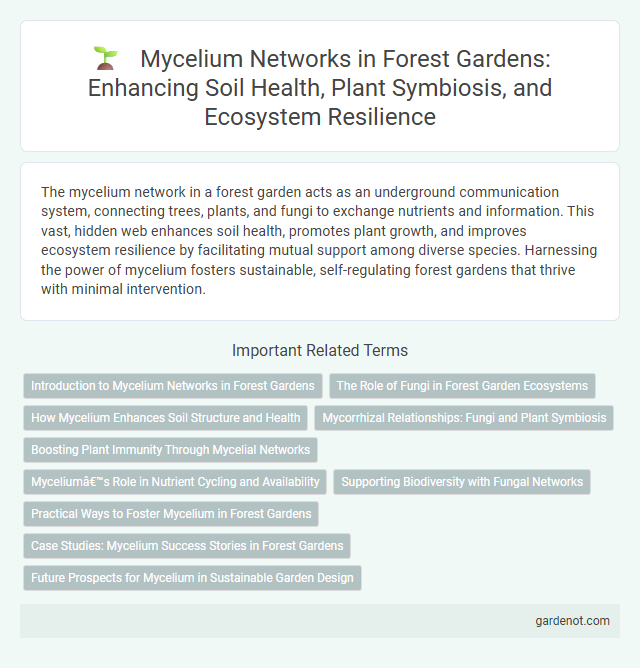The mycelium network in a forest garden acts as an underground communication system, connecting trees, plants, and fungi to exchange nutrients and information. This vast, hidden web enhances soil health, promotes plant growth, and improves ecosystem resilience by facilitating mutual support among diverse species. Harnessing the power of mycelium fosters sustainable, self-regulating forest gardens that thrive with minimal intervention.
Introduction to Mycelium Networks in Forest Gardens
Mycelium networks are underground fungal systems that connect trees and plants in forest gardens, facilitating nutrient exchange and communication. These networks enhance soil health by decomposing organic matter and increasing nutrient availability, supporting plant growth and biodiversity. Understanding mycelium is essential for designing sustainable forest gardens that mimic natural ecosystems.
The Role of Fungi in Forest Garden Ecosystems
Fungi, particularly through the mycelium network, play a crucial role in forest garden ecosystems by facilitating nutrient cycling and enhancing soil health. This underground fungal web connects plant roots, allowing for efficient water and nutrient exchange, which supports diverse plant species' growth and resilience. By decomposing organic matter, fungi release essential minerals, promote microbial diversity, and foster a balanced ecosystem vital for forest garden productivity.
How Mycelium Enhances Soil Structure and Health
Mycelium enhances soil structure by binding soil particles into stable aggregates, improving aeration and water retention essential for plant growth. The extensive fungal network decomposes organic matter, releasing vital nutrients such as nitrogen and phosphorus, which boost soil fertility. This symbiotic relationship fosters microbial diversity and disease suppression, promoting a resilient and healthy forest garden ecosystem.
Mycorrhizal Relationships: Fungi and Plant Symbiosis
Mycorrhizal relationships form a vital symbiosis between fungi and plants within a forest garden, enhancing nutrient uptake and soil health. The mycelium network acts as an underground communication system, transferring water, minerals, and organic compounds between plant roots and fungi. This mutualistic interaction increases plant resilience, promotes biodiversity, and supports sustainable ecosystem function.
Boosting Plant Immunity Through Mycelial Networks
Mycelial networks in forest gardens act as underground communication pathways, enabling plants to share nutrients and chemical signals that enhance collective immunity. These fungal networks facilitate the transfer of protective compounds and trigger immune responses in neighboring plants, reducing susceptibility to pests and diseases. Strengthening mycelial connections supports plant health by promoting resilience and adaptive defense mechanisms across the ecosystem.
Mycelium’s Role in Nutrient Cycling and Availability
Mycelium networks play a critical role in forest garden nutrient cycling by decomposing organic matter and converting it into bioavailable forms for plants. These networks facilitate the transfer of essential nutrients such as nitrogen, phosphorus, and potassium across interconnected root systems, enhancing soil fertility and plant growth. By improving nutrient availability and promoting symbiotic relationships with tree roots, mycelium supports the resilience and productivity of forest gardens.
Supporting Biodiversity with Fungal Networks
Mycelium networks enhance forest garden biodiversity by facilitating nutrient exchange and communication between plants and microbes. These fungal networks improve soil health, promote root growth, and support diverse plant species, creating a resilient ecosystem. By breaking down organic matter, mycelium fosters habitat complexity and sustains a dynamic biological community.
Practical Ways to Foster Mycelium in Forest Gardens
In forest gardens, fostering mycelium networks enhances soil health and nutrient cycling by promoting symbiotic relationships between fungi and plant roots. Practical ways to encourage mycelium growth include incorporating wood chips, leaf litter, and organic mulch as substrate, maintaining moisture through regular watering, and minimizing soil disturbance to preserve fungal hyphae. Introducing diverse fungal inoculants, such as mycorrhizal spores and decomposer fungi, further accelerates ecosystem resilience and plant vitality.
Case Studies: Mycelium Success Stories in Forest Gardens
Mycelium networks play a critical role in forest gardens by enhancing nutrient cycling and supporting plant health through symbiotic relationships with trees and understory plants. Case studies such as the Knepp Estate in England demonstrate how mycelium boosts soil fertility and biodiversity, leading to resilient forest garden ecosystems. Research from Appalachian forest gardens highlights increased crop yields and disease resistance linked to robust mycelial activity, underscoring mycelium's vital contribution to sustainable agroforestry.
Future Prospects for Mycelium in Sustainable Garden Design
The mycelium network enhances soil health by facilitating nutrient exchange and improving water retention, making it a vital component in sustainable forest garden systems. Future prospects for mycelium in garden design include its role in natural pest control, carbon sequestration, and fostering plant resilience against environmental stress. Integrating advanced mycelial technologies with permaculture principles promises to revolutionize sustainable garden ecosystems.
Mycelium network Infographic

 gardenot.com
gardenot.com